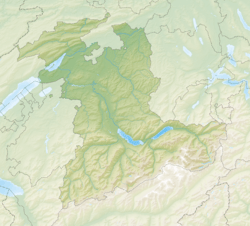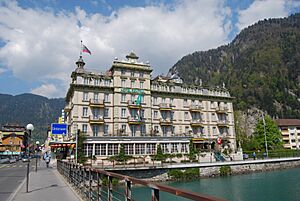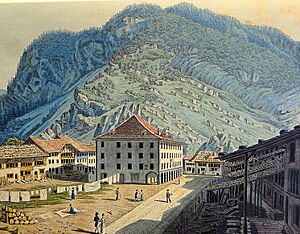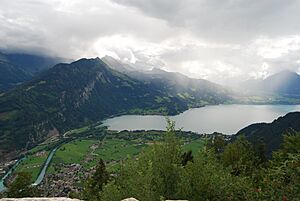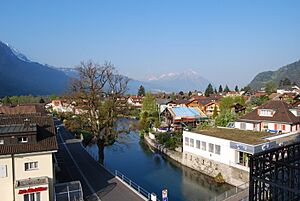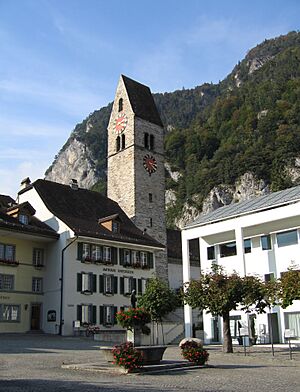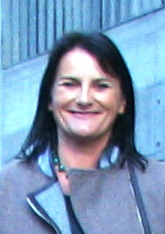Unterseen facts for kids
Quick facts for kids
Unterseen
|
||
|---|---|---|
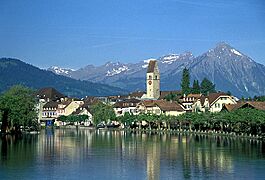 |
||
|
||
| Country | Switzerland | |
| Canton | Bern | |
| District | Interlaken-Oberhasli | |
| Area | ||
| • Total | 13.99 km2 (5.40 sq mi) | |
| Elevation
(Stedtlizentrum)
|
567 m (1,860 ft) | |
| Population
(Dec 2020 )
|
||
| • Total | 5,760 | |
| • Density | 411.7/km2 (1,066.4/sq mi) | |
| Demonym(s) | German: Unterseener(in) | |
| Postal code |
3800
|
|
| Localities | Unteres Stadtfeld, Wellenacher, Neuhaus, Mühleholz, Däleboden, Chiemberg, Stolle, Luegiwald, Hindere Harder, Harderkulm, Vordere Harder, Hohmüedig, Mühleholz, Breite | |
| Surrounded by | Beatenberg, Därligen, Habkern, Interlaken, Leissigen, Ringgenberg | |
Unterseen is a historic town and a municipality in the Interlaken-Oberhasli area of Bern, Switzerland. Its name, Unterseen, means Lower Lake. This is because the town is located on flat land near the eastern shore of Lake Thun.
Unterseen sits between two streams, the Lombach and the Aare River. Both of these flow into Lake Thun. The old part of town is mostly on the northern side of the Aare River. This river flows from Lake Brienz to Lake Thun. Just across the Aare is the town of Interlaken. Both towns are on a flat, open area called the Bödeli, surrounded by tall mountains.
Unterseen is part of the "Interlaken" city area, which had about 23,300 people in 2014. Along with Interlaken, Unterseen is a popular place for tourists in the Bernese Highlands. From the town, you can see famous mountains like the Eiger, Mönch, and Jungfrau.
Contents
A Look Back in Time
People have lived in the Unterseen area for a very long time. Stone tools from the neolithic period (New Stone Age) have been found here. Around 200 AD, during the Roman era, a graveyard was built. An even older cemetery from the Early Middle Ages shows that people lived here then too.
By the High Middle Ages, at least three forts were built in the area. The region was known as Interlacus in 1133. This was when the Interlaken Monastery was founded on the opposite side of the Aare River. A village called Interlaken grew up near the Monastery.
How Unterseen Was Founded
The city of Unterseen was officially started on July 13, 1279. King Rudolf I von Habsburg gave permission to Baron Berchtold III to build a strong fort. This fort was to be built between the two lakes. The name "Unterseen" comes from old German words meaning "between" and "lake." The new settlement was given special town rights at this time.
The town was built by local nobles. They wanted to limit the growing power of the nearby Monastery. They also wanted to control a bridge over the Aare River. This led to conflicts between the young town and the Interlaken Monastery. Unterseen soon sought protection from Bern. After the Battle of Sempach in 1386, the area came under Bern's control. Bern then appointed a local leader called a bailiff.
Fires and Rebuilding
During the Protestant Reformation, Unterseen supported Bern and did not join a local uprising. Because of their loyalty, they were given land called Alp Sefinen. In 1364, a fire started at the Monastery's mill. It spread to Unterseen and destroyed much of the town.
In 1470, Unterseen burned down a second time. Bern helped rebuild the town, placing the town hall in the center. A small church was first mentioned in 1353. It was rebuilt after the 1470 fire. The church building you see today was built in 1852. This happened after part of the older church collapsed.
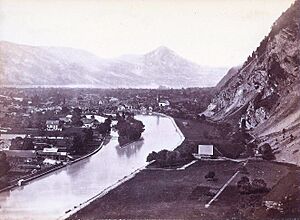
Later History
After the Helvetic Republic was created, Unterseen became a center of resistance. People here did not want the old feudal system of Bern to return. The Unspunnenfest in 1805 and 1808 was planned to help city and country people get along. But it did not work, and the government banned the festival. In 1815, many people from Unterseen were involved in unrest in Interlaken.
In the early 1800s, the old town wall and moat were removed. The gate house was taken down in 1855. In the mid-18th century, Unterseen was very important for tourism. However, much of that role has now been taken over by Interlaken.
Where is Unterseen?
Unterseen covers an area of about 13.99 square kilometers (5.4 square miles). About 18.2% of this land is used for farming. A large part, 60.1%, is covered by forests. About 15.3% of the land has buildings or roads. Rivers and lakes make up 2.6%, and 4.1% is unproductive land.
The town is on the flat land called Bödeli. This area is between Lake Thun and Lake Brienz. Unterseen is north of Interlaken, across the Aare River. The municipality includes the historic town and its village-like areas. It also has rural parts closer to Lake Thun. These include camping sites, beaches, and a golf course. There are also scattered homes and woods on the nearby mountainsides. These mountains include Dälebode, Chienberg, and Harder.
In 2010, Unterseen became part of the new Verwaltungskreis Interlaken-Oberhasli area.
Town Symbol
The symbol for Unterseen is its coat of arms. It shows a black ibex (a type of wild goat) on a gold background. The ibex is standing up and has a red tongue.
People of Unterseen
Unterseen has a population of about 5,492 people. About 14.5% of the people living here are from other countries. Over the past 10 years, the population has grown by about 11.1%. Most of this growth is due to people moving into the town.
Most people in Unterseen (about 89.1%) speak German as their first language. Portuguese is the second most common language (2.1%). Italian is the third (2.0%).
In 2008, about 47.4% of the population was male and 52.6% was female. About 25.3% of the people living in Unterseen in 2000 were also born there. About 40.2% were born in the same canton (Bern).
Population Over Time
The chart below shows how the population of Unterseen has changed over many years. You can see that the number of people living in the town has generally increased.

Important Heritage Sites
The old city of Unterseen is a very important historical place in Switzerland. The ruins of Weissenau Castle are also listed as a heritage site of national significance. The entire town of Unterseen is part of the Inventory of Swiss Heritage Sites. This means it is a special place that needs to be protected.
Economy and Jobs
In 2011, Unterseen had a low unemployment rate of 1.72%. In 2008, there were 2,243 people working in the municipality.
Types of Jobs
- Primary sector: This includes jobs like farming. About 63 people worked in this area.
- Secondary sector: This includes jobs in manufacturing and construction. About 397 people worked here.
- Tertiary sector: This includes jobs in services. This is the largest sector, with 1,783 people working in areas like sales, hotels, restaurants, healthcare, and education.
In 2008, there were 1,754 full-time jobs in Unterseen. Many people who live in Unterseen work outside the municipality. About 11.5% of workers used public transport to get to work. About 35.2% used a private car.
Religion
Based on information from 2000:
- About 16.0% of the people were Roman Catholic.
- About 65.4% belonged to the Swiss Reformed Church.
- About 10.38% belonged to other Christian churches.
- About 2.29% were Islamic.
- About 6.15% said they had no religion.
Education
In Unterseen, many people have completed higher education. About 43.0% of the population finished non-mandatory upper secondary education. About 11.5% went on to a university or a specialized college.
School System
The Canton of Bern has a specific school system:
- One year of non-mandatory Kindergarten.
- Six years of Primary school.
- Three years of mandatory lower Secondary school. Students are grouped by their abilities.
- After lower Secondary, students can continue schooling or start an apprenticeship (job training).
During the 2010–11 school year, 560 students attended schools in Unterseen. This included 81 kindergarten students, 317 primary students, and 162 lower secondary students. Some of these students were from other countries or spoke a different language at home.
Famous People from Unterseen
- Adrian Frutiger (1928–2015): A famous Swiss designer of typefaces (fonts).
- Thomas Straubhaar (born 1957): A Swiss economist and researcher.
- Christine Häsler (born 1963): A Swiss politician who has been a member of the National Council since 2015.
Sports Stars
- Marcel Perrière (1890–1966): A Swiss racing cyclist who was a national champion in 1911.
- Hansruedi Schneider (born 1926): A Swiss former sports shooter who competed in the 1960 and 1964 Summer Olympics.
- Liselotte Michel (born 1939): A Swiss alpine skier who competed in the 1960 Winter Olympics.
- Samuel Balmer (born 1968): A former Swiss professional ice hockey player who competed in the 1992 Winter Olympics.
- Eveline Bhend (born 1981): A Swiss freestyle skier who competed in the 2014 Winter Olympics.
- Franziska Kaufmann (born 1987): A Swiss curler.
Images for kids
See also
 In Spanish: Unterseen para niños
In Spanish: Unterseen para niños




